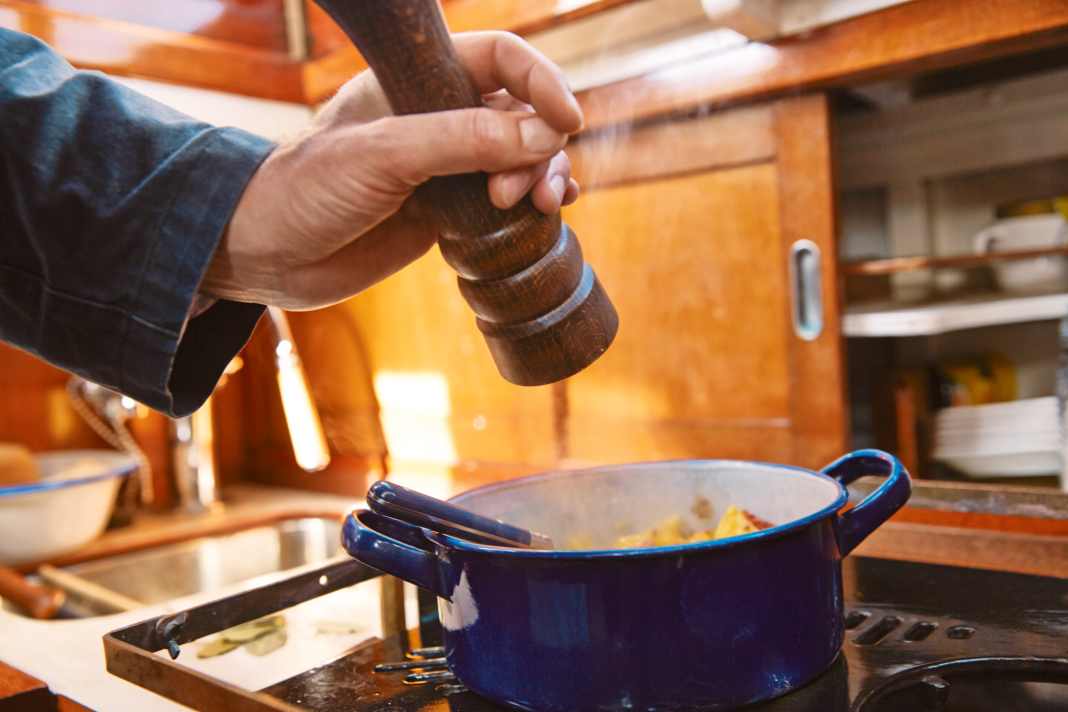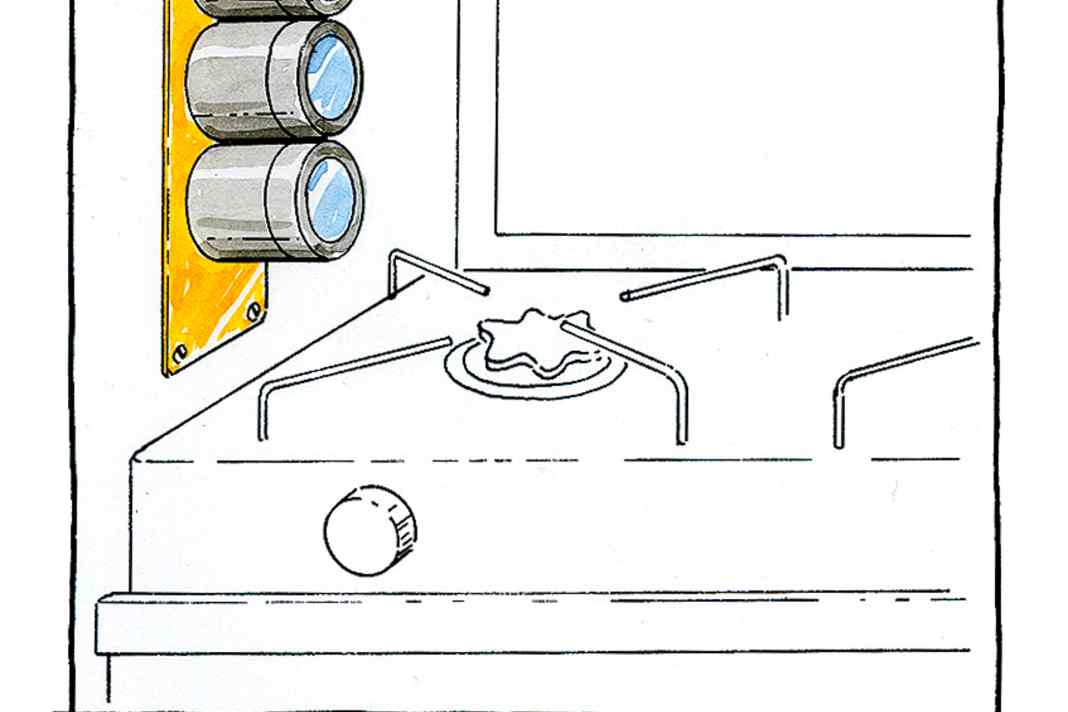





For many people, cooking on board after a long day on the water is part of sailing. Underway, however, the kitchen often remains cold. In other words, there is muesli, sandwiches, cakes or other prepared snacks. This makes it easy to get through the day and the anticipation of the evening meal increases. At the same time, however, the desire to have something proper on the plate as soon as possible after mooring or anchoring increases. Sometimes the sailing plan suffers because a hungry crew is reluctant to sail on.
The good thing is that the galleys on most yachts offer the basic requirements to be used while sailing and to conjure up something warm on the table, or rather on the plate. Because one thing is clear, the sea conditions and location are not only noticeable during preparation, but also during the meal itself.
Seaworthy pantry
Dishes that require few pots and can be eaten alone with a spoon or fork are ideal. This leaves one hand free for the plate. Because you will hardly be able to put it on the table. The crew should therefore opt for a bowl or a deep plate with a raised freeboard. Crockery with a non-slip rubber base can also be practical. This is available from Brunner, for example, in combination with unbreakable plastic. Non-slip porcelain plates and bowls, on the other hand, are usually only available in toddler designs. Speaking of anti-slip, if you don't have a suitable rubber mat on board, you can simply place a damp tea towel underneath, it also limits the mess if something goes wrong when pouring. The only disadvantage is that the towel has to be dried again after use.
Back to the galley. The question of which layout is best suited for long journeys is open to debate. Every design has advantages and disadvantages and its fans. On a summer cruise or for the occasional night cruise, it doesn't really matter whether you have an L-shaped or U-shaped layout or a longitudinal galley. In a U-shaped layout, you can wedge yourself in better and ideally have the cooker, sink, fridge and work surfaces within easy reach. However, L-shaped and longitudinal pantries can also be used when sailing. A strap can be attached for additional support. More important, because they are difficult to retrofit, are sufficiently high coamings on all work surfaces and a sink that does not fill up even when the boat is lying down. This is because it is a universal storage and work area at sea.
The cooker also needs a gimbal, it should be able to swing 25, better 30 degrees to each side. These comparatively large deflections are necessary so that pots and pans remain in place even during heeling peaks caused by swell. It should also be possible to secure the pots and pans on the cooker, as the smut will need the usual hand to hold on to them at sea. Pot holders are usually included with gimbal gas cookers, but they are available as accessories for Origo spirit cookers. Another option is customised systems that rest on the cooker like a frame and securely enclose the pots. They are particularly popular with long-distance sailors who cook at sea every day.
Alternative energy sources on the rise
Thanks to efficient induction technology, electric cooking is also becoming increasingly important, see YACHT 18/22. Provided the appropriate energy infrastructure is in place, the hobs can be used well at sea. Our author and long-distance sailor Frank Reinecke, for example, almost always cooks electrically. "Our pots and pans are all suitable for induction and gas. On passages, we cook electrically if the conditions allow it. The mobile induction hob stands on the gas hob, which is mounted on a gimbal. We use a non-slip surface on the induction hob. This method has proved very successful and saves gas when the Bolognese simmers for a long time," says Reinecke.
Also interesting:
In addition to the induction hob, Reinecke likes to use an electric rice cooker. This can also be used to bake bread and cakes. With an anti-slip mat, a rice cooker stands securely in the sink even when the boat is moving around a lot. On multihulls that sail without any significant position, even the domestic Thermomix is sometimes used.
The Omnia has proven itself for spirit and gas cookers, it is a true multifunctional appliance. Almost anything can be prepared in the simple-looking aluminium pan with lid, from potato casseroles and bread to pizza and chips.
The attachment converts gas and spirit cookers into an oven and is even worthwhile if a cooker with oven is available. If no large crew is to be catered for, the Omnia requires less gas on a low flame than the permanently installed oven. The silicone inserts available as accessories have proved their worth. However, there should be several on board, as they absorb the odour and the next cake should not taste like lasagne.
Cooking on board: good preparation saves time and resources
A big part of cooking is preparing the ingredients. Washing and chopping vegetables at sea is much more strenuous than without heeling and boat movements. It is therefore advisable to prepare the ingredients at the berth and store them temporarily in tins or zip-lock bags. A fully prepared meal is worth its weight in gold for night trips or foreseeable bad weather. Goulash, Bolognese or similar dishes are ideal, for example. Pasta or rice can almost always be cooked as a side dish, and the rest just needs to be warmed up.
Pragmatism is required when choosing ingredients. Pasta dishes, for example, taste almost as good with penne or fusilli as with spaghetti, but are much easier to eat with one hand. Here's another tip from Frank Reinecke: "Truffles or truffle oil have proved to be very effective for snacks in between meals. These products are preserved, so they keep for a long time and are easy to store. A few noodles are cooked and drained, then truffles with olive oil are added to the pot and a very tasty snack is ready to eat."
"If the conditions are too rough, we like to open a tin of ready meals and refine them while warming up. Then it's more about how we wedge ourselves into the cockpit and spoon up the soup without any accidents," says Reinecke.
Stowing the ingredients and cooking utensils ensures that everything runs smoothly in the pantry, preferably before you set off. This also includes rubbish bins, pot holders and towels. Are things organised in such a way that they are also accessible during operation? Cupboards behind the cooker are already difficult to use in harbour as soon as a pot is on the flames, and the risk of burning increases if the ship is moving. It is particularly unfavourable if the lockers are upwind and the contents spill into the galley when they are opened. You should therefore stow all the spices you need for cooking so that they can be reached with one hand and you don't have to reach over the hob. Magnetic spice jars, for example, can be helpful here. A safe storage place for kitchen knives is also practical.
Readers' tips on cooking on board






Minimise the risk of injury and accidents when cooking
Regardless of whether you are chopping with a knife or sizzling on an open flame: The risk of injury and accidents increases with the movement of the boat, so you should also keep an eye on safety. This includes a stable stance for the smut, which can be improved by the lap belt mentioned at the beginning. As a counterpart to the belt, there should also be a solid bar in front of the cooker so that you don't have to lean on the swinging cooker if the swell cancels out your balance. A fire blanket should also be to hand, but this also applies to cooking at the mooring.
The most important tip for cooking at sea is to simply try it out. The advantage for the cook: a portion of scrambled eggs or pasta with tomato sauce at sea usually tastes at least as good to a hungry crew as an elaborately cooked meal in harbour. Or as professional ship's cook and author Ulli Krause put it: "Finesse is not necessarily advisable." In any case, the warm meal lifts the spirits and releases new energy, whether for further sailing or just for a relaxing shore leave.
Book tips for the galley




